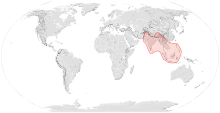| Giant honey bee | |
|---|---|

| |
| Pollinating Bidens (note pollen baskets) | |

| |
| Pollinating Mimosa pudica | |
| Scientific classification | |
| Domain: | Eukaryota |
| Kingdom: | Animalia |
| Phylum: | Arthropoda |
| Class: | Insecta |
| Order: | Hymenoptera |
| Family: | Apidae |
| Genus: | Apis |
| Subgenus: | Megapis |
| Species: | A. dorsata
|
| Binomial name | |
| Apis dorsata Fabricius, 1793
| |

| |
| Range of A. dorsata | |
Apis dorsata, the rock bee or giant honey bee, is a honey bee of South and Southeast Asia. They are typically around 17–20 mm (0.7–0.8 in) long and nests are mainly built in exposed places far off the ground, like on tree limbs, under cliff overhangs, and under buildings. These social bees are known for their aggressive defense strategies and vicious behavior when disturbed. Though not domesticated, indigenous peoples have traditionally used this species as a source of honey and beeswax, a practice known as honey hunting.[1]
- ^ Starr, Christoper (1987). "Nest-site Preferences of the Giant Honey Bee, Apis dorsata (Hymeoptera:Apidae), in Borneo". Pan-Pacific Entomologist (63): 37–42.